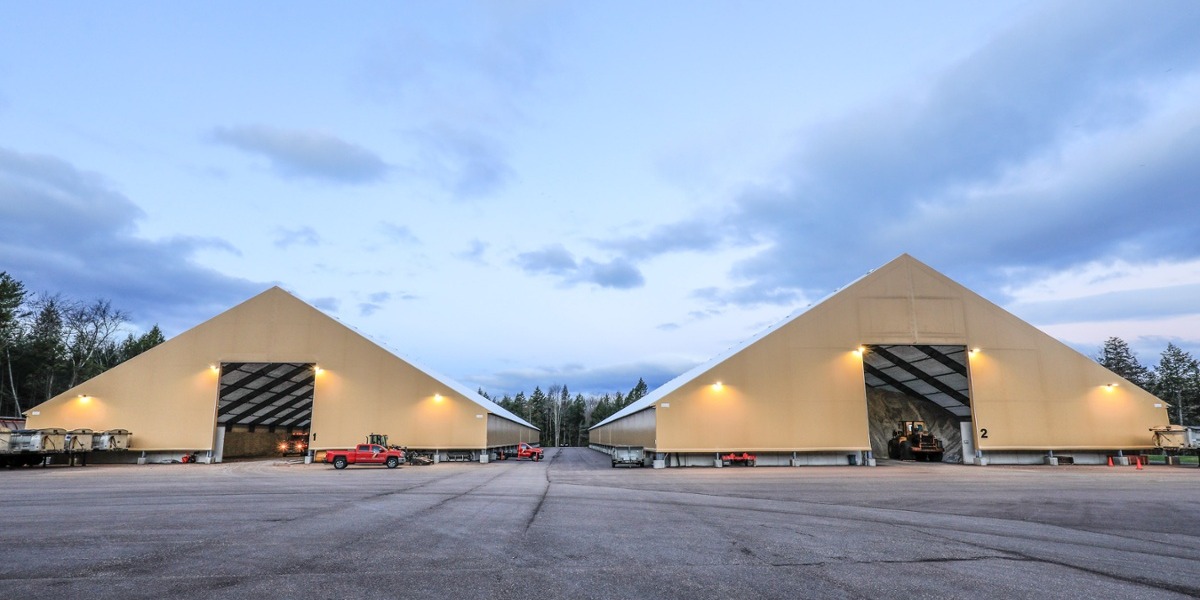Understanding the Differences: PVC vs PE Fabric

Legacy committed to a PVC architectural fabric, a proprietary cladding we call ExxoTec™, a few years back. Many other companies use polyethylene (PE) fabric, and it’s a good idea to know the differences.
PE VS. PVC FABRIC: THE SIMILARITIES
Both PVC and PE fabric are suitable for a variety of applications. Both types of fabric are rugged and durable, and designed to perform well when subjected to proper tension. Keeping the fabric tensioned both horizontally and vertically prevents most of the issues associated with the fabric structures of the past, including overstressing the fabric.
PE and PVC fabric are both available in several colors and weights. While many building owners prefer classic white cladding, creatively using other colors is a good way to enhance branding or display a company’s logo or mascot.
Learn more about PE and PVC fabric
One of the most important ways to preserve the quality of PE or PVC fabric is by adhering to manufacturing standards. Every bolt of fabric should be inspected before cutting and welding. Welding equipment must be tested to ensure it is working properly and that the fabric welds are performing as expected.
In lieu of questioning the manufacturer directly, quality certifications such as ISO 9001 are good indicators that the manufacturer is following accepted fabric handling and manufacturing practices.
Fabric panels are manufactured using hot air, wedge or RF welding, and the weld strength is nearly identical to the strength of the fabric itself. The fabric, the frame and the attachment all play a role in the strength of the building. Read more about the advantages of in-house manufacturing.
PE VS PVC FABRIC: THE DIFFERENCES
PVC and PE fabric do have some notable differences, including:
- Lifespan
- Initial cost
- Light transmittance
While there is no one universal “right” fabric, comparing the qualities of PE and PVC fabric will help the building owner specify the best material for your use. An experienced sales representative can also answer questions about structural fabric and make recommendations based on building location and use.
PVC FABRIC
PVC fabric is durable and designed to last a long time – our Exxotec has a 25-year warranty. PVC fabric is thicker and heavier than PE fabric, weighing between 20-28 ounces per square foot. Compared to PE, PVC fabric has higher tear strength, making it a popular choice for buildings that are exposed to strong winds and other extreme conditions.
PVC cladding consists of five layers: a scrim of woven fabric sandwiched between two layers of PVC, which are then sandwiched between two layers of lacquer.
The translucency of white PVC fabric is 12% which allows natural light inside the building. The benefits of natural light inside a structure have been documented and researched.
PVC fabric is naturally flame-retardant, which is an important consideration as it is a requirement of the building code for all fabric buildings. It does have a higher initial price than PE fabric, but its durability is the factor that attracts many of Legacy’s customers.
PE FABRIC
Polyethylene fabric, also called PE, is lighter type of architectural fabric, commonly weighing 12 to 15 ounces. The lower weight fabric has a lower initial price and a lifespan ranging from 15 to 20 years.
PE fabric consists of a woven inner layer, called scrim, sandwiched between two layers of plasticized coating. The coatings contain protectants including UV inhibitors. A flame-retardant coating is also available, because PE is not naturally flame-retardant.
PE fabric is also translucent and allows natural light into the building.
The quality of a fabric structure is determined by many factors – including manufacturing, frame and construction. PVC vs. PE fabric is an important consideration in fabric structure construction, but it’s not the only one. Talk to one of our project and design consultants to learn more about all the factors that go into a successful tension fabric structure.
Subscribe to our Blog
Recent Posts
- 5 Factors Every Project Owner Should Consider Before Approving Building Materials
- The 20-Year View: How Material Choices Impact Long-Term Operational Costs
- Climate Resilience in Commercial Construction: Why Traditional Methods May Not Be Enough
- Speed and Quality: The Role of Hybrid Building Materials
- Beyond the Bleachers: Designing Visually Striking Sports Facilities

